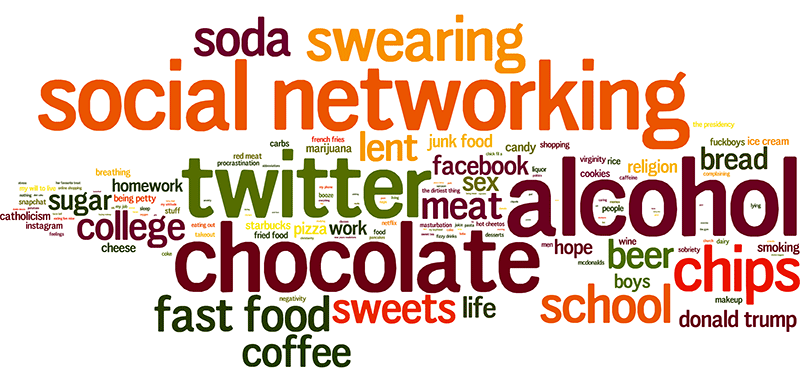
Chocolate ranks amongst the top list of things Christians give up for Lent, according to most recent Twitter data. For Christians, Lent is a period of fasting starting Ash Wednesday (March 1, 2017) and leading up to Easter Sunday (April 16, 2017), relating back to the 40 days Jesus fasted and prayed before he was ultimately crucified. Lent is a period of time in which to give up comfort such as sinful things and take on practices that serve others.
Considering chocolate and the Catholic church, there are two inverses that have evolved over time: Chocolate, once considered appropriate for consumption during Lent, is now amongst the top things people give up during Lent. Once deemed incredibly foreign and valuable, chocolate today is used to build a human-sized replica of the Pope.
Chocolate’s religious roots
Chocolate’s rich religious history stems from the Mayans who deemed chocolate ‘food of the gods’ (Coe, 1996) and prescribed it a high value. Mayans consumed chocolate beverages during rituals ranging from fertility to marriage and death rites. With the colonialization of the Americas, chocolate then made its way to Spain during the 16th century.
The Fasting Controversy
Back when chocolate was a foreign concept, Catholics looked to the Pope for guidance as to how to incorporate this novelty in their lives and particularly their Christian practices. An anecdote involves the Pope who did not deem the question whether or not chocolate was appropriate to be consumed while fasting worthy of any reply (Martin, 2017). The confusion around incorporating chocolate into their diets and its effect on religious practices had Catholic scholars debate this question and Popes beginning with Gregory XIII (1572-1588) stating privately that drinking Chocolate would not break the Catholic fast but there was never an official Papal statement (Squicciarini & Swinnen, 2016).
To understand this controversy, we need two more pieces of information: The nutritional and the geographic context. Chocolate was a new concept and there was no way to ‘ground’ it in older teachings as the bible was written during a time and in a geographic location where Chocolate was not yet a concept as the Cocoa tree just did not naturally grow anywhere but in the Americas and was not cultivated yet.
What the Fasting Controversy ultimately boiled down to and was dependent on was whether to view Chocolate as a drink which would be allowed to be consumed during fasts (Forrest & Najjaj, 2007), or food that would have to be given up due to nutritious benefits such as the added milk.
Tracing Popes’ involvement with chocolate from the 226th Pope to the current 266th Pope
There is a certain irony involved when in 2014 Pope Francis found himself standing in front of his life-sized chocolate replica, epitomizing the long and controversial history between chocolate and the Catholic church. One factor in this change in perception of chocolate is of course an economic evolutionary one: Food industrialization made more affordable the 1.5 tons of chocolate used for the statue.

Chocolate is deeply associated with Christian holidays
Nowadays, chocolate is very much intertwined with Christian holidays: Ranging from St. Valentines’ day heart-shaped chocolates, children searching for hidden chocolate Easter eggs of all colors, fillings and sizes and gifting chocolate Easter bunnies, Saint Nicholas giving out chocolate St. Nick figures to children, children’s advent calendars filled with little pieces of chocolate. It appears the end to a period of fasting is celebrated with consuming chocolate. The ritualistic tradition involved is traceable to the Mayan’s ritualistic chocolate. What has changed though is the way it is consumed: Chocolate nowadays is commonly consumed as food and not any longer as beverage and would thus not be deemed appropriate during Lent.
Social media challenges chocolate’s top-rank
Giving up chocolate seems to be a health-conscious and quick fix to what is meant to be a devout period of introspection by giving up what is hard and usually comforting. What this is, can and does change over time. The Twitter analysis also encompasses increasingly modern ‘sins’ to give up, such as social media consumption. It seems that for many Twitter users nowadays social media has taken chocolate’s sinful place. Maybe because it is seen as equally or even more addicting than chocolate and therefore giving it up is seen to be a difficult and conscious choice.
The contemporary Pope’s message
So, what are you giving up for Lent and how does chocolate’s historic significance inform your decision, if at all? While it ultimately boils down to a personal decision, there is inspiration to be found in turning to the Pope who today reaches us through the medium of Twitter along the lines of reconsidering what Lent is about and how superficial it may have become. Detaching it from only superficial food choices to something deeper and more meaningful, Pope Francis appeals to higher virtues such as reaching out to our fellow humans and neighbors.
Works Cited
Coe, S. D., Coe, M. D., & Huxtable, R. J. (1996). The True History of Chocolate. London: Thames and Hudson.
Forrest, B. M., & Najjaj, A. L. (2007). Is Sipping Sin Breaking Fast? The Catholic Chocolate Controversy and the Changing World of Early Modern Spain. Food and Foodways, 15(1-2), 31-52.
Martin, Carla D. (2017). Class Lecture. “Mesoamerica and the ‘Food of the Gods.’” Chocolate, Culture, and the Politics of Food. Cambridge, MA: Harvard University.
Squicciarini, M. P., & Swinnen, J. (2016). The Economics of Chocolate. Oxford University Press.
Multimedia Sources
Image 1: https://www.openbible.info/blog/2017/03/what-twitterers-are-giving-up-for-lent-2017-edition/
Tweets: https://twitter.com/Pontifex/status/840181704056684545 https://twitter.com/Pontifex/status/837641210583928832